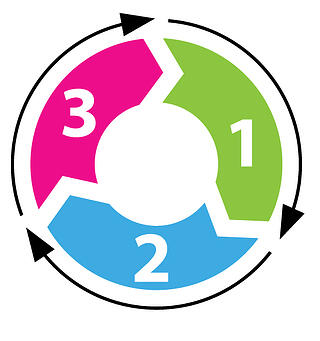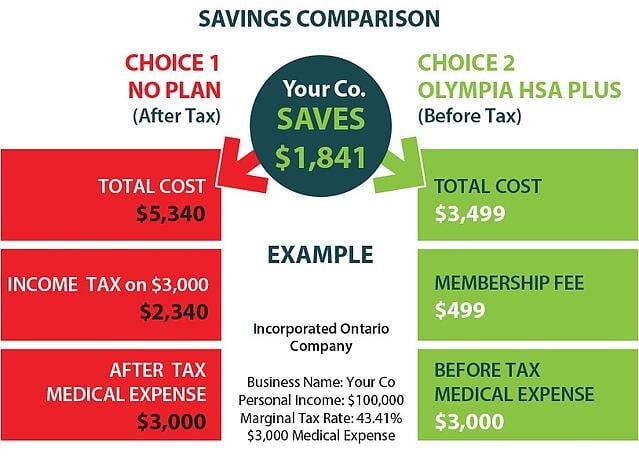Small business owners, contractors, and incorporated professionals across Canada have been successfully using Health Spending Accounts for over two decades.
Here's the 3 important tips to consider.
1. Background
Paying for medical expenses as a small business owner can be a challenge. There are only 3 options for small business owners. They can purchase an insurance plan, pay for medical bills on their own, or use a Health Spending Account.
Let’s take a look at these options.
A. Traditional Insurance
The small business owner pays a monthly premium to an insurance company in exchange for health and dental coverage. Typically, the insurance company will earn a margin of approximately 40% on their premiums meaning for every $1,000 in premium the business owner will receive $600 in benefit. In some cases, it can reach as high 65%.
Did you know that many of the events “insured” under a traditional health insurance plan are actually nothing more than administrative events that don’t require insurance? The business owner is essentially paying a 40% markup for a planned, administrative event. It makes sense to insure their home against a fire (an unplanned event). But does it make sense to buy dental insurance when they plan on visiting the dentist twice in the upcoming year? Not to mention the major expenses are paid for by them, out of pocket anyways.
On top of being expensive (deductibles, out of pocket expenses, premium creep), traditional health insurance is riddled with exclusions for pre-existing conditions, complicated claim procedures, and waiting periods.
If they are one person business, traditional health insurance may not be an option as many insurance companies require a minimum of 3 employees in order to qualify for a group plan. Unfortunately, most owner / operator businesses depend on a spousal insurance plan or medical expenses are paid out of pocket.
B. Pay for medical expenses out of pocket
Considering the expensive and restrictive nature of traditional health insurance, small business owners in Canada often elect to self insure and pay for their medical expenses out of pocket. While this can certainly prove more cost effective than a traditional insurance plan, the cost of paying for medical bills with after tax dollars can be onerous.
Take a look at the total cost of a $1,000 out of pocket medical expense to their small business. Assuming they live in Ontario, earn $100,000 per year, and have a marginal tax rate of 43%, the total cost to their business for a $1,000 medical bill is $1,750. In other words, they would need to earn $1,750 to pay for a $1,000 medical bill because 43% ($750) additional is required to pay income tax. People don’t often associate taxes to the true cost of an after tax expense, but at the end of the year, $1,000 is going to cost their business $1,750.
Now, imagine having traditional health and dental insurance for the owner’s family. The monthly premiums are $350. After 2 years on the plan and $8,400 in premiums later, they discover their teenage daughter requires orthodontics for $6,000 (a modest price). Their insurance plan covers $1,500 lifetime for orthodontics. They now have to foot a $4,500 bill AFTER tax. That’s a total cost to their business of $7,800 BEFORE TAX. Add up the remaining uncovered portions of their insurance plan, and you can begin to realize the frustration small business owners experience with health insurance.
C. Health Spending Account
Enter the third option. By using a HSA as a small business owner, they acknowledge several critical facts about health insurance. The first is that there is no rational sense in purchasing insurance for a planned event. They understand the majority of listed expenses under a health insurance plan are administrative and planned events. Paying a 40% premium on these events does not make sense.
Second, business owner realizes that exceptional and unplanned events (laser eye surgery, orthodontics, MRI) are for the most part poorly covered by a traditional health insurance plan and the majority of the cost will come out of their own pocket.
Third, the business owners sees that paying for medical expenses of out pocket is not cost effective because they are paying a substantial amount of income tax on these expenses.
Fourth, they understand the drug cost associated with a catastrophic and life threatening accident can be covered in large part by their provincial plan. If they are concerned about catastrophic drug costs associated with disease, look into a specialized non group drug plan from your province (Alberta Non Group, Trillium Ontario, BC Fair Pharmacare, Saksatchewan Drug Plan, Manitoba Pharmacare).
Given that traditional health insurance is expensive and paying for out of pocket expenses in not cost effective, the optimal solution is to pay for medical expenses through your company with a Health Spending Account.
2. What is a Health Spending Account?
A Health Spending Account is one of Canada’s best kept secrets for small business owners - it converts out of pocket, after tax medical expenses, into a before tax business expense. Since a small business owner should be self insuring their routine, planned, medical events, why not pay for them in the most cost effective way?
Qualification
A prospect or current client is a very good candidate for a Health Spending Account if they answer yes to the following questions:
1. Do I operate a business?
2. Do I have medical expenses?
3. Do I pay income tax?
Eligible Expenses
There is a wide and deep range of eligible expenses for a Health Spending Account. Here is a highlight of these expenses:
All prescription drugs
All dental - includes orthodontics
All optical - includes laser eye surgery
Paramedical - includes chiropractor, massage, physio, orthotics
Premiums - health and dental premiums paid through spousal plan
Other Expenses - MRI, tuition for special needs
Health spending accounts also provide savings to business owners where one spouse already has a traditional insured plan. The good news is spousal plan contributions can be submitted through the Health Spending Account. Co-payments for excluded items and deductibles are also eligible expenses with a Health Spending Account.
Eligible dependants are considered members of your Health Spending Account. An eligible dependant is defined as a spouse or any member of the household with whom you are connected by blood relationship, marriage or adoption, and who is financially dependent upon you at some point in the year. In addition, this dependant must be a Canadian resident, having resided in Canada for a minimum of 6 months out of the year.
Claims
Here is an example of the step by step process of making an online claim with a HSA. We will use a $1,000 medical expense in this example.
Pay the expense with your personal credit card. Submit an online claim through the provider’s online claim platform. This involves entering data surrounding the expense: name of the patient, the type of service, service date and the amount ($1,000).
After submitting the claim, your business remits an online payment to the Health Spending Account provider for the amount of the expense. This creates a trail of receipts to keep for your records ($1,000).
The Health Spending Account provider will reimburse you personally for your initial out of pocket expense (+$1,000). The reimbursement you receive is 100% tax free to you personally. The $1,000 payment from your business is %100 tax deductible.

How does a HSA save a business money?

Choice 1 Out of Pocket: After Tax Medical Expense
The medical expense is paid for by you, personally, with out of pocket after tax dollars. After tax dollar is the amount remaining after personal income tax is paid. In this example’s tax rate, your company would need to pay you $1,750 (before tax). 43% would be paid in income tax ($750).This would leave you with $1,000 (after tax) to cover the cost of your medical expense. Explained differently, each $1 you spend on medical expenses requires your company to pay you approximately $1.75 before tax. 43% (or 75 cents) is paid in tax to Canada Revenue Agency in the form of provincial and federal taxes.
Choice 2 HSA: Before Tax Medical Expense
On this side, the medical expense is paid through your corporation as a before tax business expense. Effectively, you are able to write off 100% of your medical expense through your corporation. Value is created by keeping the additional 43% tax inside your corporation.The annual fee is an example of the cost you will need to pay your provider. Cost will vary by administrator. We used $499 in this example as this is the annual, all inclusive cost of the Olympia HSA.
3. Three reasons you should market a Health Spending Account
1. Diversify Your Product Portfolio
An HSA is in the nature of insurance but it is more of a tax plan than a true insurance plan. By adding an HSA to your portfolio, you are adding diversification to the mix and expanding your knowledge base. You can impress your clients by providing a complete range of financial planning.
2. Protect Your Clients
The HSA is slowly becoming mainstream. The product was more obscure in 1997 when Olympia began pioneering the product. Today, many insurance professionals include an HSA in their repertoire of products. Ideally, you would like to add value and service your client in as many ways possible. The HSA is great way to put a fence around your client and ensure they keep their business with you.
3. Expand Your Prospect Base
An HSA is a natural door opener to your portfolio of products. An HSA sells itself and does not require the same level of commitment and trust as most financial products. You can easily qualify a lead by asking the following three questions:
1. Do they own a business?
2. Do they pay income tax?
3. Do they have medical expenses?
If they answer yes to all three questions, chances are an HSA will add value to your client. By leading with the HSA, relationship building is facilitated. When you demonstrate the savings with an HSA, you are in a trusted position to show your client other products in your portfolio. Moreover, the targets for an HSA are prime candidates for your more complex products such as life insurance and disability as they own a business and typically have a family.
Think of an HSA as your anchor product, much like mortgage at a bank. Once you have them secured with one product, you can more easily introduce your next idea.
Are you an insurance or financial professional in Canada? Disocver Olympia's Parternship Program and build your business with a Health Spending Account.
